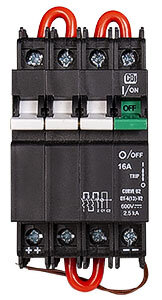You need to define string voltage, amperage and series/parallel.
That decides what IMO is needed. You read the guide?
https://downloads.imopc.com/solar-isolator-selection-guide.pdf
Yes I read that. I understand what's needed, but the diagrams and labels in the picture I posted above, which come from this very document, didn't make any sense. The two I notated as #1 & #2 say "4 Poles" but only show two connections. While I'm still a bit fuzzy, I now understand that they do indeed have 4 poles, but 2 poles are used for each polarity to handle the labeled "Higher Current/Amperage"
Are you combining strings before the IMO, in the IMO or after the IMO?
3S2P, Y combined at the panels, ran via 10 AWG. For my panels, this will be ~150V ~22A. Once 6000XP is ordered and received, it will go to 6S which will be ~300V ~11A. I would like to wire it now for the end result of ~300V ~11A, even though it will potentially be ~150V ~22A for a number of months.
That makes a difference. Before the IMO, you need a 2 pole IMO, just a negative and a positive. In the IMO, you need a 4 pole with jumpers in place so both negatives get combined and both positives. After the IMO, you need a 4 pole that keeps both strings separate, 2 negatives and 2 positives.
I'm a little confused, I would like to keep the disconnect at a minimum, a safe minimum. While I am not treating my project's voltage and amperage with disrespect, it seems like a rather simple setup from my time reading this forum, reddit, and other places over the past couple of months. Do I really need two layers of IMOs? I was gonna start with this:
the 1000V/30A version which is DC-only and lists "Internal Spatial: Bigger" as one of its differentiators from the lower rated and combo AC/DC version.
The IMO was just an option someone mentioned (and it looks fantastic). I was just not understanding their diagrams and logic for the "4 Poles" versions which only handle "1 String Max."
For example, running 2 strings of 10AWG 400 feet to an IMO that will combine those strings into parallel will be cheaper than running 1 string of 8AWG 400 feet.
Great tip, thanks!
Of course - that configuration works as a SPST switch, good for 600V. Switch PV+ only.
If you want to switch both PV+ and PV-, remove the red jumper in middle, bottom of picture.
So in the picture as shown, it is for a single wire coming in, and you'd use an identical switch for the other polarity? One entire switch as pictured for positive, and a separate entire unit for negative? And if you didn't want to go that entire distance, you simply remove the middle jumper and get two switches? The outputs would then be right next to eachother, if removing the red jumper in the middle which is on the bottom is the way you'd accomplish having the ability to handle both polarities coming in from your single string. This doesn't seem like the greatest idea.
I will have 3S2P with roughly 150V & 22A, and probably once the 6000XP is ordered and delivered, 6S for 300V 11A. While I'm all for safety, it seems like an extreme to get such a large switch for each polarity — but I will if that's what's needed.
Good news is, IF you connect polarity correctly, it is load-break rated.
(If not, be sure to make a video and post it under Up In Smoke!)
So you can throw it while it's under load? How would you normally do it with a non-load-break rated switch, try to turn the load off first? What if it's an emergency vs a planned disconnect, are you SOL with a non-load-break rated switch?




